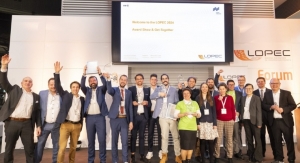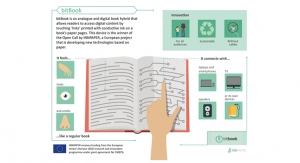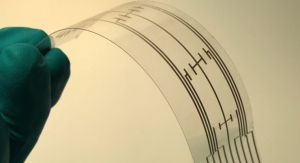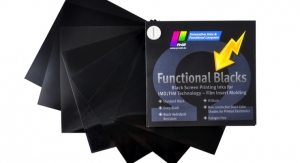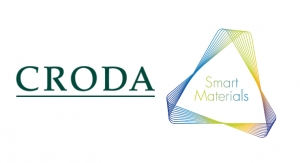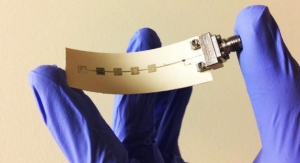12.15.17
Wearable technology is a growth market that encompasses more than just the sports and healthcare sectors. More fashion designers are including printed electronic elements into their collections. Smart clothing is another topic at LOPEC, the international exhibition and conference for the printed electronics Industry, which is taking place in Munich, Germany, from March 13-15, 2018.
Dresses lighting up to the rhythm of breathing and sweaters embracing you via mobile phone signal: Printed electronics revolutionizes fashion design and makes our outfit interactive.
“Light-emitting diodes, sensors and other components for garments must not only be extremely thin and light but also stretchable and washable. This is a very interesting field of application for printed electronics,” said Dr. Klaus Hecker, managing director of OE-A (Organic and Printed Electronics Association) and co-organizer of the annual LOPEC.
Cutecircuit from London, a pioneer in the field of electronic fashion, will present its technology in a plenary lecture at the LOPEC Conference. Among other things, the company has designed an evening dress with more than 10,000 integrated light-emitting diodes that show animated images on the flowing fabric.
Wearable electronics can, however, do much more than just blink in different colors. It lends clothing functions that could not be implemented with any other technology. One example is the Soundshirt from Cutecircuit. It was designed for deaf people and lets them “feel” concerts. There are 16 micro-actuators embedded in the fabric that translate sounds into vibrations—violins, for example, can be felt on the arm, drums in the back. Similarly, the Hug Shirt works by gently hugging the wearer when a person sends a hug signal to the shirt via mobile phone.
The question remains how durable the smart clothes are.
“In recent years, materials researchers have been able to significantly increase both the machine washability of the electronic components as well as their general resilience,” said Hecker. Researchers at the Dutch Holst Centre, for instance, have developed textiles with integrated electronics that survive up to 100,000 stretching cycles and more than 25 washing and drying cycles without any damage. The LOPEC Conference is also dedicated to this topic: During his presentation, Professor Takao Someya from Tokyo University, member of the Scientific Board of LOPEC, will talk about conductive silver pastes that can be expanded fivefold.
As LOPEC reflects the entire value chain of printed electronics, equipment manufacturers from Germany and abroad with their latest technologies will also be represented in Munich. The electronic components are printed either directly on the fabric or on thin films that can be laminated onto the textile. In the future, the fabrics could even consist entirely of conductive materials. Cutecircuit has designed a “little black dress” out of graphene, a light and yet extremely sturdy carbon material with a high electrical conductivity. Sensors that are integrated into the garment record the wearer’s breathing pattern, a microprocessor analyzes the data and changes the color of integrated LEDs depending on the depth of the breaths.

Printed electronics revolutionizes fashion design and makes outfits interactive. (Copyright: Cutecircuit).
Dresses lighting up to the rhythm of breathing and sweaters embracing you via mobile phone signal: Printed electronics revolutionizes fashion design and makes our outfit interactive.
“Light-emitting diodes, sensors and other components for garments must not only be extremely thin and light but also stretchable and washable. This is a very interesting field of application for printed electronics,” said Dr. Klaus Hecker, managing director of OE-A (Organic and Printed Electronics Association) and co-organizer of the annual LOPEC.
Cutecircuit from London, a pioneer in the field of electronic fashion, will present its technology in a plenary lecture at the LOPEC Conference. Among other things, the company has designed an evening dress with more than 10,000 integrated light-emitting diodes that show animated images on the flowing fabric.
Wearable electronics can, however, do much more than just blink in different colors. It lends clothing functions that could not be implemented with any other technology. One example is the Soundshirt from Cutecircuit. It was designed for deaf people and lets them “feel” concerts. There are 16 micro-actuators embedded in the fabric that translate sounds into vibrations—violins, for example, can be felt on the arm, drums in the back. Similarly, the Hug Shirt works by gently hugging the wearer when a person sends a hug signal to the shirt via mobile phone.
The question remains how durable the smart clothes are.
“In recent years, materials researchers have been able to significantly increase both the machine washability of the electronic components as well as their general resilience,” said Hecker. Researchers at the Dutch Holst Centre, for instance, have developed textiles with integrated electronics that survive up to 100,000 stretching cycles and more than 25 washing and drying cycles without any damage. The LOPEC Conference is also dedicated to this topic: During his presentation, Professor Takao Someya from Tokyo University, member of the Scientific Board of LOPEC, will talk about conductive silver pastes that can be expanded fivefold.
As LOPEC reflects the entire value chain of printed electronics, equipment manufacturers from Germany and abroad with their latest technologies will also be represented in Munich. The electronic components are printed either directly on the fabric or on thin films that can be laminated onto the textile. In the future, the fabrics could even consist entirely of conductive materials. Cutecircuit has designed a “little black dress” out of graphene, a light and yet extremely sturdy carbon material with a high electrical conductivity. Sensors that are integrated into the garment record the wearer’s breathing pattern, a microprocessor analyzes the data and changes the color of integrated LEDs depending on the depth of the breaths.

Printed electronics revolutionizes fashion design and makes outfits interactive. (Copyright: Cutecircuit).

